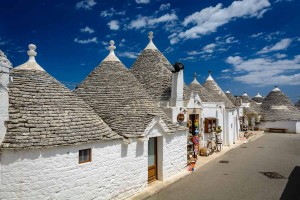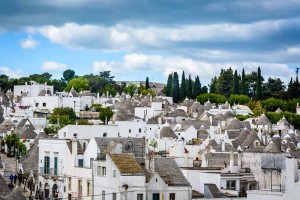
©Bigstock.com/DeyanDenchev
Crikey, what the frick are those weird pointy hats rising high into the sky? That might be your initial reaction when travelling to Alberobello. The small, tourist-heavy town in the heart of Apulia has been UNESCO World Heritage Site since 1996. The reason for receiving such a high distinction and this touristic influx are those very pointy heads resting atop the cone-shaped trulli. Read on to find out what they are all about and why Alberobello was the one place to become World Heritage Site.
What trulli are all about
Let’s be honest, they do look rather cute, don’t they? And yes, people genuinely still live inside them, even though it looks like they come from another era. Trulli don’t just look like primeval housing, discoveries prove that archetypes already existed in prehistoric times. You can find similarly primeval-looking buildings in the Provence in Southern France, which is home to the borie made from dry masonry, or in Sardinia. The latter is known for the nuraghe, tower buildings dating back to the Bonnaro culture around 2000 BC. The complex Su Nuraxi di Barumini was declared UNESCO World Heritage Site in 1997.
The construction method of the trulli hardly changed over the course of the centuries. The layout is usually round with a few rectangular exceptions. The buildings themselves are painted completely white and are made of natural stone. Meticulously arranged rectangular rooms surround the central main room. The thick walls made of limestone panels piled up without mortar isolate ideally creating warmth in winter and pleasant coolness in summer. The rock roof narrows into a corbelled vault also made of limestone panels. Capstones painted with esoteric and spiritual pictures rest on top each trullo giving it its unique look.
The legend of the trulli of Alberobello

©Bigstock.com/DeyanDenchev
Excavations prove that first settlements in Alberobello date back to the Bronze Age. The oldest trulli still standing today, however, were only built in the 14th century. Instead of repairing them, they were usually torn down and simply constructed completely anew. There’s a nice little story to go along with this method mixing historic facts and myth. In the 17th century the Count of Conversano tried to find his way around having to pay taxes to the Kingdom of Naples for creating new inhabited areas, as more and more people settled down in and around Alberobello. The Count told the settlers to only build trulli, which could be torn down quickly when the control commission was set to visit. The mortar-free construction method became mandatory turning the trulli into a local tradition.
Traditional lore aside, historians found a decisively more practical explanation why Alberobello, in particular, is home to so many trulli. The geographical location lent itself to these kind of buildings as the limestone necessary was available in close proximity. Easy extraction, short transport and uncomplicated, fast construction methods explain the rapid growth of these settlements.
Other places where you can find trulli
Trulli aren’t exclusive to Alberobello. You can find them mostly in the Val d’Itria situated between the provinces of Bari, Taranto and Brindisi. Archaeologists discovered a river, now running underground, where such settlements developed as early as the turn of the millennium. It is believed that they eventually became the villages Monti and Aja Piccola, now part of the greater Alberobello area. You can also find trulli in numerous other villages and regions of Apulia, but nowhere even nearly as many as in our picturesque UNESCO World Heritage Site.
Must-see highlights in Alberobello
There are quite a few things to discover in and around Alberobello. We’ve already talked briefly about some of the trulli highlights, but now we have all sights for you at a glance:
- Trullo Sovrano: Situated on Piazza Sacramento, it is the only two-storey trullo. It now houses a museum with interesting exhibits on the town’s history.
- Monti: The trulli hotspot encompasses a whopping 1,030 such buildings. The “Siamese Trulli” with their window-less double façade are particularly impressive.
- Aja Piccola: Alberobello’s second trulli suburb is situated around a narrow, winding road lending itself to discovery tours in historic ambiance.
- Santuario dei Santi Medici: Churches and sanctuaries also are an integral part of the town. This one holds a feretory of the holy doctors and martyrs Cosma and Damiano.
- Chiesa di Sant’Antonio: A trullo serving as a church? Sounds odd, works perfectly fine! A monumental entrance leads you into one of Italy’s most unusual religious buildings. The traditional interior will surprise you.
- Casa d’Amore: Today’s tourism office is a genuine rarity. It was Alberobello’s first pure limestone house when built in 1797.
- Rievocazione storica: Strictly speaking, this is more of a festival than a sight. In early July everyone in Alberobello wears costumes from the 16th century bringing the town’s fascinating history to life – what an experience!
While there might be a few other places where you can find those odd pointy roofs, there are nowhere near as many and as well-maintained as in Alberobello. Its palpable history and classic townscape makes the capital of trulli always worth a visit. We wish you lots of fun for your journey to this UNESCO World Heritage Site and recommend you check out our Italy section with many additional awesome ZAINOO travel suggestions!